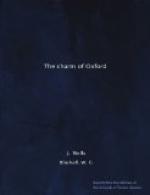Walter de Merton provided his fellows with noble buildings, at once for their common life and for their own private accommodation, and also with endowments sufficient to enable them to live in comfort, free from anxiety; most important of all, he gave them powers of self-government, so that they might recruit their own numbers and carry out for themselves the objects prescribed by him in his Statutes.
In this great foundation then the three characteristic features of a college are found—a common life, powers of self-government, with the right of choosing future members, and endowments that enable religion and learning to flourish, free from more pressing cares. It is these features which distinguish the colleges of Oxford and Cambridge, and which have determined their history.
Walter de Merton definitely prescribed that none of the fellows who benefited by his foundation should be monks or friars; to take the vows involved forfeiture of a fellowship. He also especially urged on the members of his society that, when any of them rose to “ampler fortune” (uberior fortuna), they should not forget their alma mater.
The founder died in 1277, so that none of the college buildings were complete in his time, except perhaps the treasury, which, with its high-pitched roof of stone, lies in the opposite corner of the Mob Quad to that shown in our picture. Why the Quad is called “The Mob Quad,” nobody knows. As was fitting, the chapel was the first part of the college to be finished—about 1300—and it is a splendid specimen of early Geometrical Gothic; it retains a little of the old glass, given by one of the early fellows.
The north side of the Mob Quad, which is shown in our picture, is very little later than the Chapel, and the whole of the Quad was finished before 1400; the rooms in it have been the homes of Oxford men for more than five centuries. It is sad to think that so unique a building was almost destroyed in the middle of the nineteenth century, by the zeal of “reformers”; it was actually condemned to be pulled down, to make way for modern buildings, but, fortunately, there was an irregularity in the voting. Mr. G. C. Brodrick, then a young fellow, later the Warden of the college, insisted on the matter being discussed again at a later meeting, and at this the Mob Quad was saved by a narrow majority. “He will go to Heaven for it,” as Corporal Trim said of the English Guards, who saved his broken regiment at Steinkirk.
The “reformers” of Merton had to be content with cutting down their beautiful “Grove” and spoiling the finest view in Oxford by erecting the ugliest building which Mid-Victorian taste inflicted on the University.
In the old buildings which so narrowly escaped destruction may have lived John Wycliffe, who is claimed as a fellow of Merton in an almost contemporary list; his activity in Oxford belongs rather to the later time, when he was Master of Balliol. His is one of the outstanding names in English history; the success of Merton in producing great men of a more ordinary kind can be judged from the fact that between 1294 and 1366 six out of the seven Archbishops of Canterbury were Merton men.




